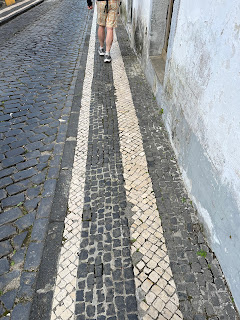And you don't need a storm to have port!
The city of Porto is famous for port, the drink. A fortified wine, port is thought to have occurred by accident. According to port lore, two Englishmen brought a shipment of port back to England in the late 17th century and added brandy to it to "fortify" it so that it would survive the long voyage. England went gaga for the new product and thus an industry and a major market was born.
 |
| Porto |
 |
| Vila Nova de Gaia across the river |
 |
the bridge linking the two -
Gustave Eiffel actually built one bridge a little up river -
this was designed by his student |
The fact that port could stay stable on long ocean voyages made it even more valuable as a commodity, as nations involved in travelling and trading around the world required months or even years at sea, and needed to keep their sailors happy.
 |
| inside a typical cellar |
 |
| cobbles and beams and the musky smell of wood and wine |
We went to - ahem - several port tastings, where we learned more about the difference between white, ruby and tawny ports. What food might go best with each. How they are all stored, whether by cask, barrel or bottle. That port of a vintage year is labeled LBV (late bottled vintage) with the year, but that port labeled 20 year, or 30 year for example, means that all the port in that blend come from different years and the average year is the year on the label. It is entirely possible to drink a glass of 40 year port that includes a product from the 19th century!
 |
| port tasting #1, excellent choices and informative at Kopke |
 |
tasting #2 - superb selection and explanation at small,
family-run Vasques de Carvalho, hard to find but well worth it -
its ports are actually made upriver, but this shop and tasting house in Gaia is lovely |
 |
| didn't like that at all (haha) |
 |
it's possible to sit at a riverside cafe and have 5 ports for 5 euros
Port is generally aged in the Douro valley, up river from Porto, but aged in cellars in the town across the river from Porto, in Vila Nova de Gaia. Those cellars still operate, and give tours and tastings to anyone who can book them in whichever language they prefer (among 6 or so). Cellars are all there, cheek by jowl, along with cafes, wine shops, and souvenir shops, so that Vila Nova de Gaia has a holiday feel to it, even as it is very much an industry town. Some of those cellars have been continuously operating for hundreds of years. Kopke is the oldest wine store (since the 1600s), although not a cellar per se, but it has tastings and a range of products to buy. |
Several have English names (e.g., Taylor's Graham's, Croft, Cockburn's, etc.), and that is because they were originally traders not producers. As England was the largest market for many years, these traders became very well known, and now produce their own port as well.
They were all established in Vila Nova de Gaia because it is much easier to transport internationally from there. The 850 km Douro river is extremely difficult to navigate. In fact, only that late 130 km is possible and only the local rabelo boats could handle it. They are distinctive wooden boats, flat-bottomed, with high tails on their sterns and huge external steering rudders.
 |
| rabelo boats with barrels of port |
 |
shipyard still operating, although these boats
are used for tourism now |
From the the late 1960s several large locks started to get installed along this stretch river to make it easier. We spent a lovely, hot, lazy day going by boat (not ship) from Porto to the village of Pinhoa, which is beautifully situated between two small rivers that empty into the large Douro. As we travelled we could see the landscape change, and vineyards set on narrow level ledges that climb high up the mountains.
Of course we tried Douro valley wines too, at the excellent Wines of Portugal centre in Porto. Four from four different regions. Portugal has 250 native grape varieties, and is very protective of them, and also avoiding the more internationally famous varieties for its wines, which makes the blends unique and impossible to replicate elsewhere.
 |
| wine regions of Portugal |
 |
| altitude changes by wine region |
 |
our four tasted from the regions of
Vino Verde, Dao, Tras-Os-Montes and Alentejo |
We know we will not be able to obtain many Portuguese wine options at home, but when we are back we will try to find more than the ubiquitous Mateus. And certainly some port.
 |
a new product - pink port - served cold at Croft winery high above Pinhoa
in the Douro valley at the end of a memorable day
(not successful in our opinion, but the location was wonderful) |




















































.JPG)





